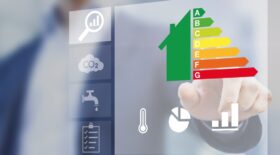Forus helped the first supermarkets in the Baltics obtain LEED certificates

Legal obligation.
The minimum requirements differ according to various building types and are increasingly strict.
An energy label becomes outdated – it must be recalculated.
More and more tenants prefer energy-efficient buildings.
Higher label – higher value of real estate.
An excellent overview of the expenses of the building.
More and more tenants of commercial buildings prefer energy-efficient buildings and consider it an important condition when selecting rental premises. Forus helps calculate energy ratings for both new and existing buildings and issues energy labels.
An energy label is a document indicating the amount of energy consumed by a building or a part thereof per square metre per year. The calculation is based on the area heated. In the next few years, our country, local governments, and the private sector face the huge challenge of reconstructing the building stock. An energy rating that is as high as possible and reducing the footprint have become a reality in our society. From the beginning of 2020, the minimum energy efficiency requirement for new buildings is a Class A building, i.e. a near-zero energy class. Reconstructed buildings must achieve the label of Class C. Existing buildings should complete calculations to determine their current class and assess the need for reconstructions.

Forus calculates energy ratings for all buildings, except for private residences. These include, for example:
We calculate the weighted energy consumption as well as the energy efficiency ratio.
An energy label can be issued to a building only by a person who has the required professional certificate (an energy performance specialist, energy auditor, issuer of energy labels for buildings).
The price of the label depends on whether the building is new or already in use. The size of the building is also taken into consideration. In the case of older buildings, the prices for the calculation of the label begin from a few hundred euros; for newer buildings, the prices start from a thousand euros.

An energy label indicates compliance with the minimum requirements for energy performance. An energy label is a document showing the amount of energy consumed by a building or a part thereof per square metre of heated area in a year.
An energy label provides information on the energy demand or the actual energy consumption of a building that already exists or that is being designed. Energy consumption is the energy used for heating or cooling the building, heating water, ventilation, lighting, use of electrical equipment, etc. in a building.
Primarily by saving energy and costs and creating a better indoor climate. The energy label of a building is an important criterion for selecting real estate.
An energy label is a prerequisite for receiving various support measures (such as guarantees and loans from KredEx).
An energy label can be issued to all buildings.
An independent energy label can be issued to a part of the building in use if there is no common heating system in the building.
Olemasoleva hoone puhul arvutab Foruse energiatõhususe spetsialist energiamärgise viimase kolme aasta tarbimisandmete põhjal. Lisaks tuleb vaadata seadmete tehnilist infot ja projektdokumentatsiooni.
Uue hoone puhul arvutatakse energiamärgis ehitusprojekti alusel teostaud energiaarvutuste järgselt. Selleks tuleb koostada energiamudel. Selleks kasutame EQUA IDA Indoor Climate and Energy tarkvara.
An energy label is valid for two years from the completion of the building (from the time of issuing a permit for use). After this period, an energy label based on the actual consumption must be issued to the building.
An energy label issued regarding the actual energy consumption is valid for ten years.
A subsequently issued energy label revokes the previous energy label of the same building or part of the building.
The first energy labels were issued in 2008–2009; therefore, the first energy labels have already expired and must be updated by ordering a new energy label.
Starting from 1 January 2018, only a person with the respective professional certification (an energy performance specialist, energy auditor, issuer of energy labels for buildings) can issue energy labels to existing and new buildings (still in the design phase).
We at Forus have an energy consumption modeller with extensive experience (diploma specialist in energy performance of buildings, level 7 – partial profession).



